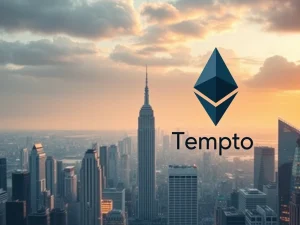Ethereum’s Astonishing Rebound: Why ETH Reclaimed $3,600 and What’s Next for 2025

The cryptocurrency world is buzzing with renewed excitement as Ethereum (ETH) stages a remarkable comeback, successfully reclaiming the crucial $3,600 mark. This impressive recovery, following a brief dip, signals a potential shift in market dynamics and has analysts eyeing a significantly bullish outlook for 2025. What exactly is fueling this resurgence, and what does it mean for the future of the second-largest cryptocurrency?
What’s Fueling Ethereum’s Ascent Beyond $3,600?
After a temporary pullback that saw Ether dip to $3,500 during Asian trading hours, Ethereum has demonstrated its resilience by firmly establishing itself back above $3,600. This recovery isn’t just a fleeting moment; it’s backed by fundamental shifts in market behavior and investor sentiment. One of the primary drivers is the observed ‘lower selling pressure’ on Ethereum compared to Bitcoin.
On-chain data, particularly the ETH/BTC exchange inflows ratio, paints a clear picture. This ratio, which measures the amount of ETH flowing into exchanges relative to BTC, remains significantly below historical extremes. CryptoQuant, a prominent on-chain analytics firm, highlighted in its weekly report that reduced inflows to exchanges typically suggest that holders are less inclined to sell. This trend often leads to sustained outperformance of ETH relative to BTC, reinforcing a bullish outlook for the pair. Essentially, fewer tokens are being sent to exchanges for potential sale, indicating that holders are confident in Ethereum’s future trajectory.
Decoding the Power of Ethereum ETF Inflows
Perhaps the most significant catalyst for Ethereum’s recent performance is the burgeoning interest in spot Ethereum ETF products. These exchange-traded funds offer institutional and retail investors regulated exposure to ETH without directly holding the cryptocurrency, opening up new avenues for capital influx. The data speaks volumes:
- Significant Inflows: U.S. spot Ethereum ETFs recorded net inflows of $332.2 million on Wednesday. This marks their seventh-highest single-day inflow since their launch, demonstrating robust demand.
- Cumulative Growth: Since their inception, these ETFs have accumulated cumulative net inflows of $8.7 million, a testament to growing investor confidence.
- Contrasting Bitcoin: This positive trend for Ethereum ETFs stands in stark contrast to Bitcoin ETFs, which experienced $285.2 million in outflows over three days, highlighting a potential rotation of capital or a diversification strategy among investors.
- Increased Exposure: The ETH/BTC ETF Holding Ratio has notably risen from 0.02 in May to 0.12. This indicates a clear shift, with investors increasing their exposure to Ethereum over Bitcoin through these regulated investment vehicles.
Currently, Ethereum ETFs collectively manage an impressive $16.6 billion in assets under management (AUM), benefiting from a consistent $3.9 billion inflow streak over the past three weeks. This sustained capital injection is a strong indicator of institutional adoption and growing mainstream acceptance, providing a solid foundation for future price appreciation.
Understanding Key ETH Price Levels: Support and Resistance
For investors and traders, understanding critical price levels is paramount. Glassnode analysts, utilizing the cost basis model, have identified key support and resistance zones for ETH Price, which can dictate its short-to-medium term movements. The cost basis model helps identify the average price at which all coins or a subset of coins were acquired, providing insights into investor behavior and potential turning points.
Key Price Levels for Ethereum:
| Level Type | Price Range | Significance |
|---|---|---|
| Strong Support | $2,000 – $3,000 | Encompasses realized prices of $2,100 (long-term holder cost basis), $2,500 (true market mean), and $3,000 (active realized price). A break below this range could signal a deeper correction. |
| Pivotal Resistance | $3,860 | A sustained move above this level is considered pivotal for triggering a potential rally towards the $4,000 mark. It represents a psychological and technical barrier. |
| Major Resistance | $4,500 | Marked by the active realized price pushed one standard deviation higher. Historical patterns from the 2020–2021 bull cycle and March 2024 highlight its significance as a formidable barrier to further gains. |
Navigating these levels will be crucial. While a sustained push above $3,860 could open the door to $4,000, the $4,500 resistance presents a significant hurdle. Analysts caution that breaching $4,500 might coincide with ‘heightened market euphoria,’ potentially leading to unsustainable price structures, as observed in previous market cycles. This emphasizes the need for a balanced approach, celebrating gains while remaining vigilant about potential overheating.
Navigating the 2025 Crypto Market Analysis for ETH
The current ETH Price action is not isolated; it reflects a broader positive shift in overall Crypto Market Analysis and sentiment. The substantial inflows into Ethereum ETFs and the reduced selling pressure indicate a maturing market where investors are increasingly comfortable with long-term positions in digital assets. This shift is critical for understanding the potential for 2025.
For investors, this presents a nuanced landscape. While the bullish indicators are strong, particularly with the continued institutional interest through ETFs, it’s important to monitor market behavior closely. The journey to new all-time highs will likely involve testing key resistance levels, and temporary pullbacks are always possible. A focus on fundamental growth, such as developments within the Ethereum ecosystem (e.g., scalability upgrades, DeFi growth), combined with these strong market indicators, provides a compelling case for optimism.
Actionable insights for investors include:
- Monitor ETF Flows: Keep a close eye on daily and weekly net inflows into spot Ethereum ETFs as a barometer of institutional interest.
- Watch ETH/BTC Ratio: A sustained outperformance of ETH against BTC indicates strong relative strength.
- Observe Key Price Levels: Use the identified support and resistance levels ($2,000-$3,000, $3,860, $4,500) to inform trading and investment decisions.
- Assess Market Sentiment: Be aware of periods of extreme euphoria, as these can precede corrections.
Conclusion: A Bright Horizon for Ethereum?
The recent reclamation of $3,600 by Ethereum, fueled by significant ETF inflows and reduced selling pressure, paints a decidedly optimistic picture for its future. The growing institutional appetite for Ethereum exposure through ETFs, coupled with strong on-chain metrics, suggests that ETH is well-positioned for further gains. While key resistance levels, particularly at $4,500, present challenges, the overall sentiment points towards a robust 2025. As the crypto market continues to evolve, Ethereum’s foundational role and increasing adoption through regulated products make it a compelling asset to watch.
Frequently Asked Questions (FAQs)
1. What are Ethereum ETFs and why are they important?
Ethereum Exchange-Traded Funds (ETFs) are investment vehicles that allow investors to gain exposure to the price movements of Ethereum without directly owning the cryptocurrency. They are important because they provide a regulated, accessible, and often more liquid way for both institutional and retail investors to participate in the Ethereum market, leading to significant capital inflows and increased market legitimacy.
2. How does ‘lower selling pressure’ affect Ethereum’s price?
‘Lower selling pressure’ means that fewer Ethereum tokens are being sent to cryptocurrency exchanges for the purpose of being sold. When the supply available for sale decreases while demand remains stable or increases, it typically leads to an upward movement in price. This indicates that existing holders are confident in Ethereum’s future value and are choosing to hold onto their assets.
3. What is the significance of the ETH/BTC exchange inflows ratio?
The ETH/BTC exchange inflows ratio compares the amount of Ethereum flowing into exchanges relative to Bitcoin. When this ratio is low, it suggests that ETH is experiencing less selling pressure compared to BTC. This can indicate a sustained outperformance of ETH against BTC, meaning Ethereum’s price might be growing faster or holding its value better than Bitcoin’s, which is generally considered a bullish sign for ETH.
4. What are the key resistance levels Ethereum needs to overcome for further gains?
According to Glassnode analysts, key resistance levels for Ethereum include $3,860 and $4,500. A sustained move above $3,860 is crucial for a push towards $4,000. However, $4,500, which has historically acted as a significant barrier, represents a major hurdle that, if broken, could indicate strong market euphoria and potentially lead to new all-time highs, but also warrants caution regarding unsustainable price structures.
5. Is the current Ethereum price surge sustainable?
While the recent Ethereum price surge is backed by strong fundamentals like significant ETF inflows and reduced selling pressure, sustainability depends on several factors. Continued institutional adoption, the overall crypto market sentiment, and Ethereum’s own network developments will play a role. Analysts caution that rapid increases, especially when nearing historical resistance like $4,500, could lead to ‘heightened market euphoria’ and potential corrections, so a balanced perspective is advised.










